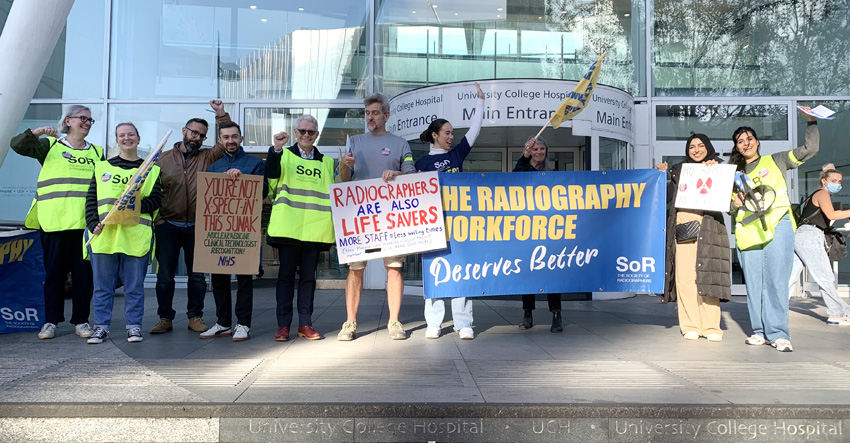THE NHS will haemorrhage staff unless pay is restored to match national averages, the Society of Radiographers (SoR) warned on Tuesday.
The SoR has submitted written evidence to the NHS Pay Review Body to highlight the issue.
NHS professionals have seen their pay grow by up to 30 per cent less than the national average – and they will leave in huge numbers unless the government remedies this, the Society of Radiographers has told the Pay Review Body.
In its written evidence to the Pay Review Body (PRB), the Society of Radiographers highlighted the fact that, over the last 16 years, all NHS grades have seen their pay fall in relation to average pay across the economy.
The gap is now between 12 per cent and 30 per cent. For graduate-entry roles, it is close to 20 per cent.
This has contributed to acute shortages in the radiography workforce – meaning ever-increasing waiting lists and delays for patients.
Dean Rogers, executive director of industrial strategy for the Society of Radiographers, said: ‘NHS salaries are not only less than the private sector, but less than other parts of the public sector as well. NHS graduates are now among the few in the UK public sector with a starting salary still below £30,000. The average starting salary elsewhere is, we believe, getting closer to £35,000.
‘This inevitably has an impact on the study choices of those considering public-sector graduate careers.’
As well as restoring NHS pay in line with average wage growth, the SoR recommends that the government provides a range of additional benefits to reduce the economic strain on NHS workers. These include free nutritious food, subsidised travel and subsidised rent or housing.
Around nine out of ten NHS patients are supported by a radiographer. From X-rays to MRI and CT scans, ultrasounds to breast screening to radiotherapy for cancer, doctors and nurses cannot do their jobs without a team of radiographers, sonographers and radiography assistants.
Radiographers are central to addressing the ever-growing NHS waiting lists. However, there is a chronic shortage of radiographers – the average vacancy rate for radiography is 15 per cent, which means that some departments’ vacancy rates are much higher.
The radiography workforce crisis is particularly acute in the specialist fields of sonography and mammography.
The Society of Radiographers is calling on the PRB to address this shortage by making pay recommendations for the medium-term and long-term.
Rogers said: ‘We know that 29 per cent of the sonography workforce is near or beyond normal retirement age. And yet there is no clear plan to train up radiographers to replace this workforce. Worse, members who want to train in specialisms such as sonography are told they’ll have to leave their post or drop down a pay band in order to do so, because there isn’t sufficient capacity in their team to release them.
‘Underfunding and a lack of long-term planning has led to other invidious choices, too. Hospitals are not filling vacant posts, because funding may not be sustainable – which in turn means that they’re forced to turn down flexible-working requests. In a largely female workforce, such as radiography, this means that radiographers end up leaving their jobs.
‘The SoR has also heard of managers turning down end-of-budget offers of funding for new equipment, because there is no matching staffing budget. Equally, managers working with slow and ageing machinery are being challenged about the efficiency of their teams.
‘The Long Term Workforce Plan for the NHS states that the radiography workforce needs to double by 2035. If we want to stand any chance of meeting that target, there needs to be significant investment in recruiting, retaining and training radiographers – including salaries that attract people to a career in the NHS, rather than making them want to leave.’
In its submission, the Society of Radiographers called for the PRB to:
- Award a significant above-inflation pay award for NHS staff at all grades for 2025-26. This will help to bring NHS pay in line with the rest of the economy.
- Conduct a comprehensive review of current pay and reward structures, with the focus on recruiting and retaining a highly skilled workforce.
- Immediately restore the starting rate for graduates (Band 5) to the level it would have reached had it grown in line with the rest of the UK economy since 2008 – an 11 per cent increase.
- Introduce automatic progression from Band 5 to Band 6 after two years – with matching salary increase – for all NHS workers who are meeting the appropriate professional standards.
- Immediately increase the starting point for NHS staff in a managerial position (Band 8a upwards) by a minimum of 10 per cent more than the headline increase, with a commitment to restore the rate of starting pay for these leadership grades by 2027.
- Prevent any NHS staff member being asked to take a pay cut to complete training for enhanced, advanced and consultant levels of radiography practice, where qualifications would help address a shortage of critical skills.
- Recommend a range of softer benefits for NHS employees, including: free nutritious food; subsidised travel, especially for those travelling at night; student-loan holidays for new professionals or those in shortage areas; subsidised rent or housing for key groups, including new professionals, international recruits and those in understaffed areas; and protected study time for training and professional development.
- Ensure that none of the pension thresholds move for those working regular contracted hours in 2024-25.
• Urgently review the package of support and systems needed to encourage international recruitment, and ensure that international recruits are included in any NHS-wide incentive schemes.
